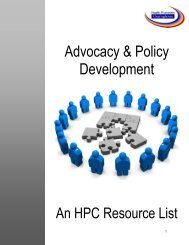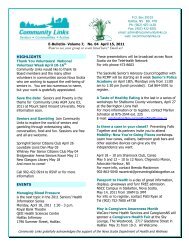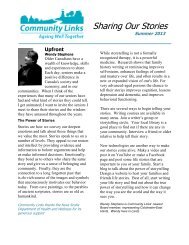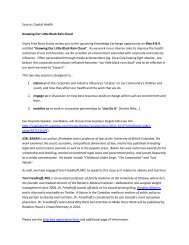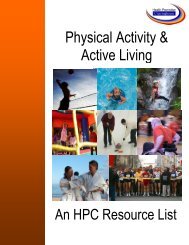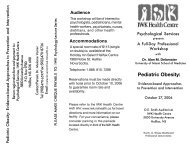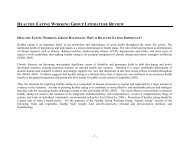Workplace Health Promotion Resource List
Workplace Health Promotion Resource List
Workplace Health Promotion Resource List
Create successful ePaper yourself
Turn your PDF publications into a flip-book with our unique Google optimized e-Paper software.
<strong>Workplace</strong> <strong>Health</strong><br />
<strong>Promotion</strong><br />
An HPC <strong>Resource</strong> <strong>List</strong><br />
1
The <strong>Health</strong> <strong>Promotion</strong> Clearinghouse would like to extend a very special thank<br />
you to the many reviewers who took the time to make suggestions and<br />
additions to the draft versions of these lists.<br />
This resource list is a work in progress. Please help us keep it up-to-date by<br />
contacting us with suggestions and/or additions.<br />
Production made possible through funding from the Nova Scotia Department of<br />
<strong>Health</strong> <strong>Promotion</strong> and Protection<br />
For more information, please contact:<br />
<strong>Health</strong> <strong>Promotion</strong> Clearinghouse<br />
Suite 209, City Centre Atlantic<br />
1535 Dresden Row<br />
Halifax, Nova Scotia<br />
B3J 3T1<br />
Telephone: (902) 494-1917 or Toll Free: 1-877-890-5094<br />
Fax: (902) 494-3594<br />
E-mail: hpc@dal.ca<br />
www.hpclearinghouse.ca<br />
The information contained within this resource list is intended for education and information purposes only. The information is not<br />
a substitute for professional advice. Although care has been taken in preparing the information contained in this resource list, the<br />
<strong>Health</strong> <strong>Promotion</strong> Clearinghouse (HPC) does not and cannot guarantee the accuracy thereof. All resources selected have met<br />
our quality assurance criteria; however the HPC does not endorse any of the resources listed within. Anyone using the<br />
information does so at their own risk and shall be deemed to indemnify the HPC from any and all injury or damage arising from<br />
such use. For information on our quality assurance criteria please contact HPC.<br />
2
<strong>Workplace</strong> <strong>Health</strong> <strong>Promotion</strong><br />
• Overview ................................................................................................................. 3<br />
• Documents ............................................................................................................. 4<br />
• Organizational Links ............................................................................................... 9<br />
• Other Tools and <strong>Resource</strong>s .................................................................................11<br />
Overview<br />
What is <strong>Workplace</strong> <strong>Health</strong> and Why is it Important? 1<br />
<strong>Workplace</strong> health is a comprehensive and integrated approach focusing on the general population at<br />
a workplace as well as the organization as a whole. <strong>Workplace</strong> health addresses a broad range of<br />
health issues including physical and psychosocial, environment, health practices, personal<br />
resources, etc. through programs, policies and practices. The three main areas targeted by<br />
workplace health are: Occupational <strong>Health</strong> and Safety, Organizational <strong>Health</strong>, and <strong>Health</strong>y Choices.<br />
The benefits of implementing workplace health strategies to create a workplace supportive of wellbeing<br />
are: Less turnover and absenteeism, increased ability to cope with stress and change,<br />
improved morale, increased productivity and job satisfaction, a reduction in workplace injuries,<br />
increased retention and recruitment, and improved company culture.<br />
What You Will Find In This Document:<br />
Within the “<strong>Workplace</strong> <strong>Health</strong> <strong>Promotion</strong>” resource list, you will find a variety of information from<br />
provincial, national and international sources on the topic of promoting a healthy working<br />
environment. This resource list is organized into four sections: Overview, Documents, Organizational<br />
Links, and Other Tools and <strong>Resource</strong>s. A brief description of each section is included below:<br />
Overview provides a general description of the topics represented in this resource list.<br />
Documents is made up of toolkits and reports that are available online.<br />
Organizational Links lists relevant provincial, national and international groups affiliated with<br />
promoting workplace health.<br />
Other Tools and <strong>Resource</strong>s includes key websites, databases, and portals related to healthy<br />
workplaces.<br />
1 Adapted from the Canadian Centre for Occupational <strong>Health</strong> and Safety website (2007): www.ccohs.ca/<br />
3
Documents<br />
Best Advice on Stress Risk Management in the <strong>Workplace</strong> Part 1 and Part 2<br />
Author: Shain, M.<br />
Date: 2000<br />
Source: <strong>Health</strong> Canada<br />
Description: The primary purpose of this publication is to raise awareness and inspire action concerning the<br />
very real risks to health and safety posed by certain kinds of toxic stress in the workplace. As<br />
such, the materials can be used as a presentation and can also be used on a self-instructional<br />
basis. They can also be used to assist in the development of workplace surveys and the<br />
understanding of results from these surveys. Included in the materials are numbered<br />
overheads that can be copied onto acetates for use in an overhead presentation.<br />
URL: http://www.mentalhealthpromotion.net/?i=promenpol.en.toolkit.124<br />
and<br />
http://www.mentalhealthpromotion.net/resources/stress-part-2-eng.pdf<br />
Building a <strong>Health</strong>y <strong>Workplace</strong> – Blueprint for Success<br />
Author: Middlesex-London <strong>Health</strong> Unit<br />
Date: 2004<br />
Source: Middlesex-London <strong>Health</strong> Unit<br />
Description: This step-by-step guide can assist organizations in creating healthier workplaces. Here you<br />
will find 15 different topic areas with practical ideas on how you can raise awareness and<br />
build skills among employees, create a supportive workplace environment, and develop<br />
healthy policies.<br />
URL: http://www.ccohs.ca/healthyworkplaces/topics/activeliving.html<br />
The Case for Comprehensive <strong>Workplace</strong> <strong>Health</strong> <strong>Promotion</strong>: Making “Cents” of a Good<br />
Idea<br />
Author: The <strong>Health</strong> Communication Unit<br />
Date: 2004 (updated)<br />
Source: The <strong>Health</strong> Communication Unit<br />
Description: This easy to read document outlines the benefit and rational for creating a comprehensive<br />
workplace health promotion plan.<br />
URL:<br />
http://www.thcu.ca/infoandresources/resource_display.cfm?searchString_keyword=making+<br />
good+cents&advanced=yes&translateto=english<br />
Comprehensive <strong>Workplace</strong> <strong>Health</strong> <strong>Promotion</strong>: Recommended and Promising<br />
Practices for Situational Assessment Tools<br />
Author: The <strong>Health</strong> Communication Unit<br />
Date: 2006<br />
Source: The <strong>Health</strong> Communication Unit<br />
Description: This resource is designed to help workplace health promotion intermediaries in Ontario<br />
select and implement situational assessment tools in their workplace, and replicate and/or<br />
adapt the best practice process and methodology used to generate the tools. It contains 29<br />
recommended and promising tools in six categories: needs assessments, health risk<br />
appraisals, workplace environmental audits, employee interest surveys, current practice<br />
surveys, and organizational culture surveys.<br />
URL: www.thcu.ca/<strong>Workplace</strong>/sat/pubs/sat_v102.pdf<br />
4
Creating <strong>Health</strong>y <strong>Workplace</strong>s<br />
Author: Burton, J.<br />
Date: 2006<br />
Source: Industrial Accident Prevention Association<br />
Description: This document shows that there are excellent legal and economic reasons to strive for a<br />
healthy workplace, and it doesn’t have to be difficult or expensive. It does take some<br />
awareness, commitment and persistence on the part of employers and employees, but the<br />
outcomes in terms of worker health, job satisfaction, employee morale, and the company’s<br />
productivity and bottom line, make it well worth the effort for all workplace parties.<br />
URL: www.iapa.ca/pdf/2004_HWP_<strong>Health</strong>y_<strong>Workplace</strong>_FINAL.pdf<br />
Ending Canada’s Invisible Epidemic: A Strategy for Injury Prevention<br />
Author: Smart Risk<br />
Date: 2005<br />
Source: Smart Risk<br />
Description: This document outlines the need for a pan-Canadian injury prevention strategy, current<br />
foundations, and recommendations.<br />
URL: http://www.ohpe.ca/node/6950/print?PHPSESSID=ffc0538f1f57fd8d508d3f1260659e52<br />
Evaluating Comprehensive <strong>Workplace</strong> <strong>Health</strong> <strong>Promotion</strong><br />
Author: THCU Comprehensive <strong>Workplace</strong> <strong>Health</strong> <strong>Promotion</strong> Project Team<br />
Date: 2005<br />
Source: The <strong>Health</strong> Communication Unit<br />
Description: This Info-pack focuses on key aspects of evaluation within the CWHP framework. It is designed<br />
for busy practitioners who support the development of CWHP initiatives in their community and<br />
would like to access practical, 'how-to' information about program evaluation.<br />
URL: www.thcu.ca/workplace/documents/EvaluationInfoPackFinalWeb.pdf<br />
First Nations Occupational <strong>Health</strong> and Safety: A Discussion Paper<br />
Author: First Nations Centre<br />
Date: 2006<br />
Source: First Nations Centre<br />
Description: The First Nations population has been growing more quickly than other groups in Canada,<br />
and this trend has accelerated in the past 10 years. The proportion of the population of First<br />
Nations communities that is under 20 year of age is almost double that of the Canadian<br />
population as a whole. With a growing and comparatively young population, it is evident that<br />
there will be many more First Nations people entering the workforce in the years to come.<br />
This paper will identify and discuss occupational health and safety issues which may be of<br />
particular relevance to First Nations people, and recommendations for future research will<br />
be suggested.<br />
URL: http://www.naho.ca/documents/fnc/english/FNC_Occupational<strong>Health</strong>andSafety.pdf<br />
5
Guide to Nutrition <strong>Promotion</strong> in the <strong>Workplace</strong><br />
Author: Nutrition <strong>Resource</strong> Centre<br />
Date: 2002<br />
Source: Nutrition <strong>Resource</strong> Centre<br />
Description: This “how to” guide is designed to help practitioners promote, implement and support<br />
nutrition programs in the workplace. Sample resources included are: workplace nutrition<br />
assessment tools, sample policies and program logic models. This Guide is primarily<br />
intended for use by public and community health practitioners who are interested and<br />
ready to implement nutrition programs in the workplace. With the support and assistance<br />
of public health departments and/or community health centres, the Guide may also be a<br />
useful resource for occupational health staff, workplace health and safety representatives,<br />
human resource professionals, workplace wellness teams and other professionals<br />
involved in workplace health promotion programs.<br />
URL: action.web.ca/home/nutritio/attach/Nut%20Promo%20Guide.pdf<br />
Influencing the Organizational Environment to Create <strong>Health</strong>y <strong>Workplace</strong>s Info-pack<br />
Author: THCU Comprehensive <strong>Workplace</strong> <strong>Health</strong> <strong>Promotion</strong> Project Team<br />
Date: 2004<br />
Source: The <strong>Health</strong> Communication Unit<br />
Description: This Info-pack focuses on one element of the CWHP approach – the organizational<br />
environment. It is designed for practitioners who support the development of healthy<br />
workplaces in their community and would like to increase their understanding of the ways<br />
in which the organizational environment affects workplace health.<br />
URL: www.thcu.ca/workplace/documents/influencing_org_envir_infopackv_1.1.FINAL.pdf<br />
Introduction to Comprehensive <strong>Workplace</strong> <strong>Health</strong> <strong>Promotion</strong> Info-pack<br />
Author: THCU Comprehensive <strong>Workplace</strong> <strong>Health</strong> <strong>Promotion</strong> Project Team<br />
Date: 2004<br />
Source: The <strong>Health</strong> Communication Unit<br />
Description: This Info-pack is designed for health promotion practitioners who are relatively new to the<br />
area of workplace health promotion or are looking for a refresher on current theory and<br />
practice. It provides an overview of comprehensive workplace health promotion, examines<br />
steps for helping workplaces take effective action, shares practical ideas and strategies to<br />
consider, and outlines available resources.<br />
URL: www.thcu.ca/workplace/documents/intro_to_workplace_health_promotion_v1.1.FINAL.pdf<br />
National Study on Balancing Work, Family and Lifestyle / l'Étude nationale sur<br />
l'équilibre entre le travail, la famille et le style de vie<br />
Author: Duxbury, L. and Higgins, C.<br />
Date: 2002-2005<br />
Source: Public <strong>Health</strong> Agency of Canada<br />
Description: This website contains links to the following four reports: The 2001 National Work-Life<br />
Conflict Study (2002), Work-Life Conflict in Canada in the New Millennium A Status Report<br />
(2003), Exploring the Link Between Work-Life Conflict and Demands on Canada's <strong>Health</strong><br />
Care System (2004) and Who Is at Risk? Predictors of Work-Life Conflict (2005)<br />
URL/ www.phac-aspc.gc.ca/publicat/work-travail/index.html<br />
L’URL: www.phac-aspc.gc.ca/publicat/work-travail/index-fra.php<br />
6
Time Escapes Me: Workaholics and Time Perception / Les bourreaux de travail et<br />
leur perception du temps<br />
Author: Keown, L.A.<br />
Date: Unknown<br />
Source: Statistics Canada<br />
Description: Using data from 2005 General Social Survey on time use, this article examines those<br />
people who identify themselves as workaholics. This report asks if this self-identification<br />
affects their quality of life as measured by the balance between work and family time, time<br />
pressure and general life satisfaction.<br />
URL/ www.statcan.ca/english/freepub/11-008-XIE/2007001/pdf/11-008-XIE20070019629.pdf<br />
L’URL: www.statcan.gc.ca/pub/11-008-x/2007001/pdf/9629-fra.pdf<br />
Voices of Canadians: Seeking Work-Life Balance / Témoignages canadiens : À la<br />
recherche de la conciliation travail-vie personnelle<br />
Author: Duxbury, L., Higgins, C., and Coghill, D.<br />
Date: 2003<br />
Source: Human <strong>Resource</strong>s Development Canada<br />
Description: By documenting people's responses in their own words, this report illustrates very clearly<br />
how people are experiencing often extreme levels of stress due to the conflict between<br />
work and home. This report is therefore a valuable record that provides first-hand insights<br />
into a burgeoning problem for individuals and organizations.<br />
URL/ http://publications.gc.ca/collections/Collection/RH54-12-2003E.pdf<br />
L’URL: http://publications.gc.ca/collections/Collection/RH54-12-2003F.pdf<br />
Work Stress and <strong>Health</strong> / Le stress au travail et al santé<br />
Author: Wilkins K., and Beaudet, M.<br />
Date: 1998<br />
Source: Statistics Canada<br />
Description: This article describes work stress experienced by the employed population. It examines<br />
associations between job strain, job insecurity, physical demands, low co-worker support<br />
and low supervisor support, and four health outcomes: migraine, work injury, high blood<br />
pressure and psychological distress.<br />
URL/ www.statcan.ca/english/studies/82-003/archive/1998/hrar1998010003s0a04.pdf<br />
L’URL: www.statcan.gc.ca/studies-etudes/82-003/archive/1998/4140-fra.pdf<br />
Work Time and the Future of Work in Canada: A Nova Scotia GPI Case Study<br />
Author: Pannozzo, L. and Colman, R.<br />
Date: 2004<br />
Source: GPI Atlantic<br />
Description: In this three-part report, paid work is examined not only for its contribution to income and<br />
growth, as in most standard economic analyses, but from a broader perspective of<br />
“genuine progress” and human wellbeing. Part 1 investigates the quantitative trends in<br />
paid work hours over the last several decades, particularly in Nova Scotia. Part 2<br />
examines costs associated with these trends in work that are invisible in our current<br />
system of accounting. Part 3 presents the perceived benefits of shorter work time, as well<br />
as obstacles to shorter work time from the perspective of employees, employers, and<br />
unions. Policy recommendations that flow from the evidence are discussed, as well as the<br />
areas where more data are required.<br />
URL: www.gpiatlantic.org/pdf/workhours/workhours.pdf<br />
7
Your Rights, Responsibilities and the Occupational <strong>Health</strong> and Safety Act<br />
Author: Nova Scotia Department of Environment and Labour<br />
Date: 2005<br />
Source: Nova Scotia Department of Labour and Workforce Development<br />
Description: This document outlines Nova Scotian’s rights and responsibilities when on the job, along<br />
with the Nova Scotian governments Occupational <strong>Health</strong> and Safety Act.<br />
URL: www.gov.ns.ca/lwd/healthandsafety/docs/YourRightsandResp-en.pdf<br />
8
Organizational Links<br />
Canadian Centre for Occupational <strong>Health</strong> and Safety<br />
Contact: Address: 135 Hunter Street East, Hamilton ON Canada L8N 1M5<br />
Telephone: (905) 572-2981<br />
Fax: (905) 572-2206<br />
E-mail: clientservices@ccohs.ca<br />
Website: www.ccohs.ca/<br />
Description: The Canadian Centre for Occupational <strong>Health</strong> and Safety provides resources and<br />
information about the strong connection between the health and well-being of people and<br />
their work environments. The <strong>Health</strong> Communication Unit at the Centre for <strong>Health</strong><br />
<strong>Promotion</strong> at the University of Toronto leads a workplace health promotion project.<br />
Canadian Occupational <strong>Health</strong> Nurses Association<br />
Address:<br />
E-mail:<br />
Website:<br />
206 Locke Street South, Floor 1, Hamilton, ON L8P 4P4<br />
info@cohna-aciist.ca<br />
www.cohna-aciist.ca<br />
Description: Occupational <strong>Health</strong> Nurses from across Canada have been meeting informally since<br />
1980. The formal association was founded in 1984 and incorporated in 1994. The<br />
COHNA/ACIIST continues to evolve and be the voice of Occupational <strong>Health</strong> Nurses in<br />
Canada.<br />
Institute for Work and <strong>Health</strong><br />
Contact: Address: 481 University Avenue, Suite 800, Toronto, ON M5G 2E9<br />
Telephone: (416) 927-2027<br />
Fax: (416) 927-4167<br />
E-mail: info@iwh.on.ca<br />
Website: www.iwh.on.ca/<br />
Description: The Institute for Work & <strong>Health</strong> is an independent, not-for-profit organization whose<br />
mission is to conduct and share research with workers, labour, employers, clinicians and<br />
policy-makers to promote, protect and improve the health of working people.<br />
National Quality Institute<br />
Contact: Address: 2275 Lake Shore Blvd. West, Suite 307 Toronto, ON M8V 3Y3<br />
Telephone: (416) 251-7600<br />
Toll Free: 1-800-263-9648<br />
Fax: (416) 251-9131<br />
Website: www.nqi.ca<br />
Description: Assists Canadian organizations, both public and private, in the development of quality and<br />
healthy workplace practices. Offers management tools, training, networking, promotion,<br />
access to best practices, independent and peer assessments, and certification programs.<br />
9
Nova Scotia Department of Labour and Workforce Development – Occupational<br />
<strong>Health</strong> and Safety Division<br />
Contact: Address: PO Box 697, 5151 Terminal Road, Halifax, NS B3J 2T8<br />
Telephone: (902) 424-5300<br />
Fax: (902) 424-0503<br />
Website: www.gov.ns.ca/lwd/ohs/<br />
Description: The Occupational <strong>Health</strong> & Safety Division (OH&S) concentrates its efforts on safe and<br />
healthy workplaces, and work practices, and safety standards protecting the general public.<br />
The Division seeks to continuously improve the provision of its services. The OH&S Division<br />
focuses on the promotion of the internal responsibility system. The system acknowledges<br />
the responsibility of employers and employees for workplace health and safety.<br />
Worker’s Compensation Board of Nova Scotia<br />
Contact: Address: 5668 South Street, Halifax, NS<br />
Telephone: (902) 491-8999<br />
Toll Free: 1-800-870-3331<br />
Website: http://www.wcb.ns.ca<br />
Description: The WCB is committed to keeping Nova Scotians safe and secure from workplace injury. It<br />
provides workplace injury insurance for more than 18,000 employers, representing about<br />
300,000 workers across the province. The WCB sets the standard for workplace injury<br />
insurance by informing and inspiring Nova Scotians in the prevention of workplace injury.<br />
10
Other Tools and <strong>Resource</strong>s<br />
Active Living At Work / La vie active au travail<br />
Author: Public <strong>Health</strong> Agency of Canada<br />
Date: Last updated 2004<br />
Source: Public <strong>Health</strong> Agency of Canada<br />
Description: Active Living is a key determinant of health and well-being. As such, it is an important<br />
component of <strong>Health</strong> Canada's population health and disease prevention strategies.<br />
Increasing physical activity levels in Canada will not only improve the health and wellbeing<br />
of Canadians, but also has the potential to produce large health-care cost savings.<br />
The Business Case for Active Living at Work is the third major initiative undertaken by<br />
<strong>Health</strong> Canada to improve the physical activity levels of Canadians since 1998.<br />
URL/ www.phac-aspc.gc.ca/pau-uap/fitness/work/<br />
L’URL: www.phac-aspc.gc.ca/pau-uap/condition-physique/au_travail/index.html<br />
Bullying in the <strong>Workplace</strong><br />
Author: Canada Safety Council<br />
Date: Last updated 2000<br />
Source: Canada Safety Council<br />
Description: This website offers information on psychological violence, workplace policies, perpetrators<br />
and targets, profile of a bully, the burden of bullying, prevention information and links to<br />
other sources providing a peaceful and bully free work environment.<br />
URL: http://canadasafetycouncil.org/workplace-safety/bullying-workplace<br />
The Canadian Best Practices Portal for <strong>Health</strong> <strong>Promotion</strong> and Chronic Disease<br />
Prevention / Le Portail canadien des pratiques exemplaires en matière de<br />
promotion de la santé et de la prévention des maladies chroniques<br />
Author: Various<br />
Date: Last updated 2009<br />
Source: Public <strong>Health</strong> Agency of Canada<br />
Description: This portal allows you to search for best practices tools and resources. Simply type in<br />
search words related to workplace health.<br />
URL/ cbpp-pcpe.phac-aspc.gc.ca/<br />
L’URL: cbpp-pcpe.phac-aspc.gc.ca/index-fra.html<br />
Corporate <strong>Health</strong> Model / Modèle de promotion de la santé dans l'entreprise<br />
Author: <strong>Health</strong> Canada<br />
Date: Unknown<br />
Source: <strong>Health</strong> Canada<br />
Description: The Corporate <strong>Health</strong> Model (developed by <strong>Health</strong> Canada) provides large and mediumsized<br />
corporations with a proven, step-by-step approach for determining the real needs of<br />
employees for health programming. This model then shows how a worksite committee of<br />
managers and labour representatives can develop a long-term plan to prioritize and address<br />
these health-related needs. Also see Corporate <strong>Health</strong> Model - A Guide To Developing And<br />
Implementing The <strong>Workplace</strong> <strong>Health</strong> System In Medium And Large Businesses<br />
URL/ http://www.mentalhealthworks.ca/employers/free-resources/workplace-healthsystem/corporate-health-model<br />
L’URL:<br />
http://www.mentalhealthworks.ca/fr/workplace-health-system/modele-de-promotion-de-lasante-dans-lentreprise<br />
11
Physical Activity @ Work: Bringing Physical Activity into the Workday<br />
Author: Alberta Centre for Active Living<br />
Date: Last updated 2007<br />
Source: Alberta Centre for Active Living<br />
Description: This user-friendly website helps employers, employees, workplace wellness coordinators and<br />
human resources advisors encourage physical activity at work.<br />
URL: www.centre4activeliving.ca/workplace/<br />
Work / Life Balance in Canadian <strong>Workplace</strong>s / Conciliation travail-vie dans les<br />
milieux de travail<br />
Author: Public <strong>Health</strong> Agency of Canada<br />
Date: Last updated 2007<br />
Source: Public <strong>Health</strong> Agency of Canada<br />
Description: This website has been created to help organizations design and implement supportive<br />
programs and policies facilitating work-life balance. By reducing work-life struggles,<br />
individuals can enjoy a healthier lifestyle while improving productivity at work. The first<br />
section allows employers, unions, managers and human resources practitioners to access<br />
the latest information and examples of best practices that enhance work-life balance for<br />
their employees. The second section highlights the issues of an aging workforce.<br />
URL/ http://www.ccohs.ca/healthyworkplaces/topics/worklifebalance.html<br />
L’URL: http://www.cchst.ca/healthyworkplaces/topics/worklifebalance.html<br />
Work Safe. For Life<br />
Author: Worker’s Compensation Board of Nova Scotia<br />
Date: Last updated 2006<br />
Source: Worker’s Compensation Board of Nova Scotia<br />
Description: This website and social marketing campaign offers information on preventing injury,<br />
returning to work, and a media campaign on the effects of workplace injury.<br />
URL: www.worksafeforlife.ca/<br />
<strong>Workplace</strong> <strong>Health</strong> <strong>Promotion</strong> <strong>Resource</strong> Search<br />
Author: Canadian Centre for Occupational <strong>Health</strong> and Safety<br />
Date: Unknown<br />
Source: Government of Canada<br />
Description: This database provides comprehensive coverage of workplace health information and<br />
includes references to reports, articles, organizations, conference proceedings, and<br />
consumer health materials.<br />
URL: http://ccinfoweb.ccohs.ca/workplacehealth/search.html<br />
<strong>Workplace</strong> <strong>Health</strong> System - The Small Business <strong>Health</strong> Model / Système de<br />
promotion de la santé en milieu de travail - Modèle pour les petites entreprises<br />
Author: <strong>Health</strong> Canada<br />
Date: Unknown<br />
Source: <strong>Health</strong> Canada<br />
Description: The Small Business <strong>Health</strong> Model is an approach to health promotion developed by <strong>Health</strong><br />
Canada and coordinated through provincial ministries and agencies. This overview<br />
describes the steps and answers the most common questions about the Small Business<br />
<strong>Health</strong> Model. Also see The Small Business <strong>Health</strong> Model - A Guide to Developing and<br />
Implementing the <strong>Workplace</strong> <strong>Health</strong> System in Small Business<br />
12



